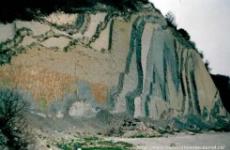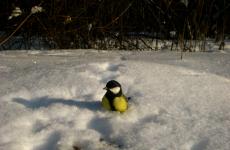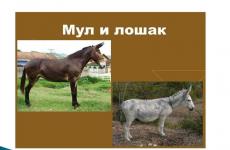Presentation on the topic "Isolation - an evolutionary factor." Isolation is an evolutionary factor Presentation on the topic of deproductive isolation
Reproductive isolation in evolutionary biology is a mechanism that prevents the exchange of genes between populations. The division of gene pools of populations in some cases leads to the formation of new species. Reproductive isolation can be accomplished by preventing fertilization or by producing nonviable or sterile hybrids, such as mules or hinnies. (A mule is a hybrid of a horse and a donkey, a hinny is a hybrid of a donkey and a mare).

There are two known mechanisms of reproductive isolation: prezygotic and postzygotic. Prezygotic mechanisms that precede the formation of a zygote create obstacles to the mating of individuals belonging to different populations. Postzygotic act after the formation of the zygote, leading to a decrease in the viability or fertility of the hybrid offspring.

The following forms are distinguished in prezygotic isolation: 1) Ecological isolation 2) Temporary isolation 3) Ethological isolation 4) Mechanical isolation 5) Gametic Postzygotic reproductive isolation occurs due to: 1) non-viability of hybrids: the zygote develops into a hybrid with reduced viability (the embryo dies at different stages of development, the young organism dies, the hybrid does not reach sexual maturity); 2) sterility of hybrids: hybrids are viable, but they do not form full-fledged gametes; 3) degeneration of hybrids; destruction of hybrids: hybrids produce descendants whose viability and fertility are reduced.

1) Ecological isolation - isolation due to environmental separation. Populations live in a common territory, but in different habitats and therefore do not meet with each other. Quercus coccinea prefers moist, poorly drained soils. Quercus velutina prefers dry, well-drained soils.


3) Ethological isolation is associated with the behavioral characteristics of females and males during reproduction. The complex ritual of identifying a mating partner is genetically programmed and almost completely eliminates the possibility of mating with individuals of another species. When the moment of reproduction comes, the males begin to actively court their females. If you watch birds during the mating season, you can watch how the male courtes the female, or rather, dances his mating dance in front of her with his tail outstretched.




2) sterility of hybrids. CMS in corn (cytoplasmic male sterility). Corn is a monoecious plant; Her female flowers are collected in a spadix, while her male flowers are collected in a panicle. Sometimes underdeveloped pollen containing sterile pollen are found in the panicle. It turned out that the sterility of pollen is determined by certain features of the cytoplasm.


1 slide
Isolation is an evolutionary factor. The work was completed by 11th grade student Natalya Vasilyeva 2011

2 slide
Isolation is a very important evolutionary factor, since it leads to divergence in the characteristics of individuals within the same species and prevents individuals of different species from interbreeding with each other.

3 slide
Types of isolation Primary isolation: Geographical Ecological Secondary isolation: Complex ritual mating actions (behavioral) Morphological (mechanical) Physiological (gametic)

4 slide
Geographical isolation Its essence lies in the rupture of the single area in which the species lived into parts that do not communicate with each other. Reasons: insurmountable barriers between population areas, i.e. the formation of mountains or rivers, isthmuses or straits, the extermination of populations in certain areas, etc. Over time, this leads to significant differences in their genotypic structure and a weakening and even complete cessation of gene exchange between populations. The result of geographic isolation is that individual populations become isolated, so free crossing of individuals from different parts of the range turns out to be either impossible or extremely difficult.

5 slide
An example of geographic isolation The Galapagos Islands have a large number of endemic birds. For example, the famous finches, which form a separate subfamily (Geospizinae), which includes 12 species belonging to several genera. These birds evolved in the Galapagos Islands from some South American species, adapting to different types of food, which left its mark on the formation of beaks in different species.

6 slide
Galapagos Finches Large cactus finch Galapagos Journey. Ground Finch Galapagos Journey.

7 slide
Ecological isolation Essence: representatives of different populations cannot interbreed and populations become isolated. Reason: contact of individuals is prevented by different habitats of populations. This type of isolation is based on differences in the preferences of animals or plants to settle in a certain place and interbreed at a strictly defined time of year. Some salmon fish, for example, do not spawn annually, but every other year. Moreover, one population of fish comes to spawn in the same spawning area in an even year, and another in an odd year. Result: an obstacle to the crossing of individuals from different populations, the initial stage of population divergence.

8 slide
An example of ecological isolation Biotype "A" with autumn spawning spawned from the beginning of November to the end of December at the northwestern shores of the lake at depths of 0.5-5 m. Biotype "B" spawned from mid-January to the end of March in the southeastern part of the lake and in the Ardanish Bay at great depths - up to 22 m. Compared to other races, the winter Ishkhan had the highest fertility - from 1422 to 8700 eggs. His growth rate was also much higher. The winter Ishkhan fed exclusively on amphipods. Sevan trout
Slide 2
Isolation is a very important evolutionary factor, since it leads to divergence in the characteristics of individuals within the same species and prevents individuals of different species from interbreeding with each other.
Slide 3
Types of insulation
Primary insulation:
- Geographical
- Ecological
Secondary insulation:
- Complex ritual mating actions (behavioral)
- Morphological (mechanical)
- Physiological (gametic)
Slide 4
Geographical isolation
- Its essence lies in the rupture of the single habitat in which the species lived into parts that do not communicate with each other.
- Reasons: insurmountable barriers between population areas, i.e. the formation of mountains or rivers, isthmuses or straits, the extermination of populations in certain areas, etc. Over time, this leads to significant differences in their genotypic structure and a weakening and even complete cessation of gene exchange between populations.
- The result of geographic isolation is that individual populations become isolated, so free crossing of individuals from different parts of the range turns out to be either impossible or extremely difficult.
Slide 5
Example of Geographic Isolation
The Galapagos Islands have a large number of endemic birds. For example, the famous finches, which form a separate subfamily (Geospizinae), which includes 12 species belonging to several genera. These birds evolved in the Galapagos Islands from some South American species, adapting to different types of food, which left its mark on the formation of beaks in different species.
Slide 6
Galapagos finches
- Large cactus finch Galapagos Journey.
- Ground Finch Galapagos Journey.
Slide 7
Environmental insulation
- Essence: representatives of different populations cannot interbreed and the populations become isolated.
- Reason: contact of individuals is prevented by different habitats of populations. This type of isolation is based on differences in the preferences of animals or plants to settle in a certain place and interbreed at a strictly defined time of year. Some salmon fish, for example, do not spawn annually, but every other year. Moreover, one population of fish comes to spawn in the same spawning area in an even year, and another in an odd year.
- Result: an obstacle to the crossing of individuals from different populations, the initial stage of population divergence.
Slide 8
Example of environmental insulation
- Biotype "A" with autumn spawning reproduced from the beginning of November to the end of December near the northwestern shores of the lake at depths of 0.5-5 m.
- Biotype "B" spawned from mid-January to the end of March in the southeastern part of the lake and in the Ardanish Bay at great depths - up to 22 m. Compared to other races, the winter Ishkhan had the highest fertility - from 1422 to 8700 eggs. His growth rate was also much higher. The winter Ishkhan fed exclusively on amphipods.
- Sevan trout
Slide 9
Lake Sevan
Slide 10
Secondary insulation
- Reproductive isolation is ethological isolation (it is characteristic only of animals and is based on genetically programmed complex rituals for identifying a mating partner, for example, the famous grouse current).
- Morphological isolation (associated with the color and size of individuals, with the structural features of the genital organs).
- Physiological isolation (death of gametes or their inability to fertilize when introduced to individuals of other species).
Slide 11
- Conclusion: various types of isolation, on the one hand, create the prerequisites for the divergence of populations and subsequent speciation, and on the other, contribute to the preservation of the genetic structure of the species.
View all slides
“The Doctrine of Evolution” - The saturation of natural populations with recessive mutations. Binary nomenclature. 1. ? Ch. Lyell - geology. The principle of correlation. Comparative anatomical: 2 – idioadaptation, allogenesis. Combinative. They do not direct the evolutionary process. Combined classical Darwinism and the achievements of genetics; Factors of evolution?
“Evolutionary theories” - Mutational variability - material for selection. Pimenov A.V. New data refuted the prevailing ideas about the immutability of living nature. Repetition: But the theory was not accepted. Is it possible to agree with Lamarck's 2nd law? Topic: “The emergence and development of evolutionary concepts.” Improved the botanical language - established a uniform botanical terminology.
“Evolutionary process” - Examples of similar organs: 1. Similar in external structure. 2.Perform the same functions. Divergence. Chiroptera. Barberry needles. The emergence of similar organs (butterfly wing and bird wing). Mammals. Bottom of onions. 2. Mastery of similar living conditions by representatives of different systematic groups.
“Development of evolutionary teaching” - Atavisms. Rudiments. Evolution theory. Carl Linnaeus (1707 - 1778). The ability of organisms to reproduce unlimitedly. Variability. Changing scientific ideas about the origin and development of life on Earth. Embryos of different organisms. Archeopteryx. As a result: Morphological Genetic Ethological Physiological Ecological Geographical.
“Evolutionary teaching” - “Evolutionary teaching”. A) artificial and natural selection; C) directed historical development of living nature; A) artificial selection; B) aromorphoses do not immediately provide organisms with victory in the struggle for existence; B) view; D) a section of biology that gives a description of all existing and extinct organisms.
“Stages of evolution” - Synthesis of biological monomers from gases of the primary atmosphere. On primitive earth, protein synthesis could take place on the surface of the earth's crust. Stages of life formation. American biochemist Cyril Ponnaperuma achieved the formation of nucleotides and ATP. Stage II. Stage I. Content.
There are 11 presentations in total
Forms of intraspecific isolation. Spatial isolation occurs between populations that are widely separated from each other or separated by geographic barriers. Ecological isolation is a form of biological isolation, based on the diversity of organisms in their reproductive ecology and preferred habitat.
Slide 5 from the presentation "Processes of Speciation". The size of the archive with the presentation is 156 KB.Biology 10th grade
summary of other presentations“Problems of the origin of life on Earth” - Coacervate droplets. Representations of ancient and medieval philosophers. Works by L. Pasteur. History of carbon. From carbon to proteins. Development of life. Conditions for the emergence of primitive living beings. Theories of the origin of life. The emergence of primary organisms. History of ideas about the origin of life. Age of the Earth. Possibility of occurrence of complex organic compounds. The emergence of life on Earth.
“Vegetation of the fields” - Research Map. Drude-Uranow abundance scale. Purpose of the study. Changes in vegetation when abandoned fields become overgrown. Hypothesis. Conclusions. Scheme map of the Predgorny region. Tasks. Practical significance. Herbaceous plants that dominate the cover of abandoned fields. Beginning of overgrowth. An example of ecological secondary succession. Development of life on Earth.
“Theories of the origin of living things” - Lesson structure. Hypotheses about the origin of life. My best lesson. Matter. Nebula. Stages of the emergence of the solar system. Theories of origin. Game regulations. The problem of nature. Rules of judicial ethics. History of performances. Modern hypotheses. Debate. Chemical evolution transition diagram. History of ideas about the origin of life. Lesson stage. Additional question. Public lesson. Group work in the lesson.
“Homeless animals in Moscow” - System for issuing memos. Ways to solve the problem. Introduction. World of volunteers. Socialization of dogs living in a shelter. Relevance and effectiveness of use. Finding previous owners for lost pets. City programs. Helping shelter animals find new homes. There are many, many animals that need our help. Conditions for keeping animals in municipal shelters. Control over the maintenance of animals from new owners.
“Hypotheses of the origin of life” - The hypothesis of biochemical evolution, or the “coacervate hypothesis”. Creationism. Divine creation of the world. Origin of man. Spontaneous generation. Stationary state. Pansmermia hypothesis. Hypotheses of the origin of life: A.I. Oparin gave primacy in the formation of life to proteins, and J. Haldane - to nucleic acids. Oparin-holdin theory. Hypotheses.
“Mitosis, meiosis and amitosis” - Robert Remak. Amitosis. Hematoxylin-eosin staining - cells dividing by amitosis. The process of mitosis can vary depending on the type of cell. A zygote is a totipotent (that is, capable of giving birth to any other) cell. When the chromosomes reach the poles, telophase begins. During the anaphase stage, chromosomes move to the poles of the cell. In mitosis, the genetic material of the parent and daughter cells is identical.





